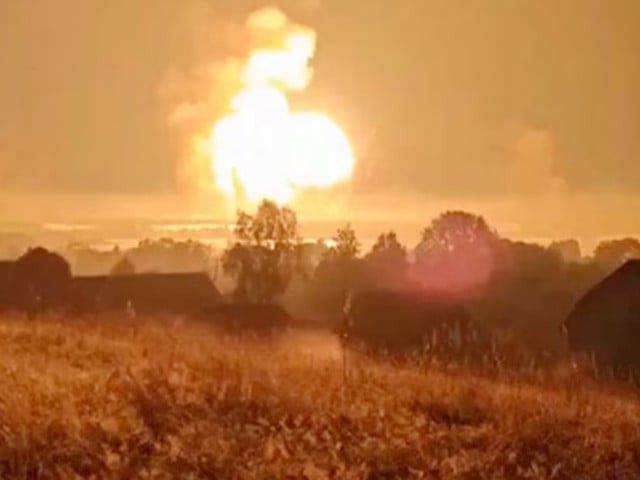According to Ukrainian sources, the depot housed critical military assets, including Iskander and Tochka-U tactical missile systems, guided aerial bombs, and artillery ammunition.
The destruction of this facility represents a major blow to Russia’s missile capabilities, particularly in light of its strategic importance.
The drone strike triggered a massive explosion, causing widespread fires and extensive damage to the depot and surrounding areas.
Satellite images released by Maxar Technologies show plumes of smoke rising from several buildings in the depot complex, with nearby forests also engulfed in flames.
The extent of the damage was significant, with reports of entire buildings and large sections of the depot being leveled by the blast.
Ukraine’s Security Service (SBU) confirmed to media outlets that the facility was targeted as part of an ongoing strategy to cripple Russia’s military infrastructure.
“This is part of a methodical plan to reduce Russia’s missile potential,” a Ukrainian security source said.
The source added that further strikes on similar military installations are already in the works, indicating that this drone attack is just one of many aimed at weakening Russia’s defense capabilities.
The scale of the explosion was such that it generated seismic activity. Ben Dando, a seismologist from the Norwegian seismology research foundation NORSAR, told CNN that seismic sensors in northwest Russia detected signals between magnitude 2.5 and 2.8, which were consistent with the timing and location of the drone strike.
NORSAR has been using seismic monitoring systems to track the impact of the war in Ukraine, further underlining the strike’s intensity.
In response to the drone attack, Russian authorities ordered the evacuation of nearby residents. Igor Rudenya, the governor of Tver, confirmed that emergency services were working to contain the fires and maintain public order.
Affected residents, including 11 children, were evacuated to nearby settlements in the neighboring Pskov region, according to Russian state news agency TASS. So far, there have been no reports of civilian casualties, though local authorities have continued to monitor the situation closely.
While Russian state media initially downplayed the strike, attributing the fire to debris from downed drones, videos circulating on social media tell a different story.
Verified footage shows loud detonations and large sections of the depot in flames. Russian military bloggers have since criticized the incident, questioning the depot’s security measures and accusing Russian forces of mishandling their missile and ammunition stockpiles.
President Volodymyr Zelensky of Ukraine hailed the success of the attack in a speech Wednesday, without explicitly mentioning the event.
“A very important result was achieved last night on Russian territory, and such actions weaken the enemy. I thank everyone involved. Such precision is truly inspiring,” Zelensky said.
His remarks reflect a broader Ukrainian strategy of targeting Russian military infrastructure deep inside Russian territory, especially as Ukrainian forces continue their counteroffensive efforts in occupied regions of Ukraine.
Toropets, the location of the depot, lies approximately 300 miles from the Ukrainian border and around 250 miles west of Moscow, making the strike particularly significant.
Ukraine has been urging its allies, including the United States, to permit missile strikes deeper into Russian territory. The strike on Toropets represents one of the deepest incursions yet, and it has prompted warnings from Russian President Vladimir Putin.
He cautioned NATO members that if Ukraine is allowed to use long-range missile systems on targets within Russia, it could lead to a confrontation with NATO itself.
The attack also comes amid a broader trend of increased Ukrainian drone strikes on Russian military and logistical targets, as Kyiv continues to push for more advanced military aid from its Western allies. These strikes have raised concerns within Russia about the vulnerability of key military installations.
The destruction of the depot will likely cause logistical challenges for Russian forces, particularly regarding the replenishment of missile systems and artillery ammunition.
As the war continues, the destruction of critical Russian infrastructure by Ukrainian forces could further tilt the balance in Ukraine’s favor.
Such operations are designed not only to deplete Russia’s stockpiles but also to disrupt its capacity to wage a prolonged conflict. With further drone attacks likely on the horizon, the long-term impact on Russia’s military readiness remains to be seen.
Meanwhile, Ukraine’s continued push for military aid from its Western allies will likely intensify, as it seeks to capitalize on these strategic gains.
In the broader geopolitical context, this incident highlights the increasing complexity of the war, as both sides escalate their strategies.
The destruction of the depot will likely be remembered as one of the most consequential strikes by Ukraine, further intensifying an already volatile conflict.







